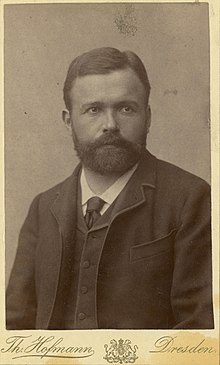|
Caspar Badrutt
Caspar Badrutt (21 July 1848 - 28 June 1904) was a Swiss businessman, hotelier and restaurateur. He was the founder and proprietor of the famous Badrutt's Palace in St. Moritz. Badrutt was almost solely responsible in creating the development of the village in an international skiing destination.[1] Early life and educationBadrutt was born on 21 July 1848 in Samedan to Johannes and Maria (née Berry) Badrutt. His younger brother, Peter Robert Badrutt (1850-1907), was a serial businessman and Grand Councilor of Grisons from 1897 to 1898 (Liberals).[2] CareerHe initially worked for his fathers hotel, Hotel Engadiner Kulm, before founding Badrutt's Palace in 1896. St. Moritz in the 19th century was known as a summer mineral spa town where the rich and royal took mineral cures during the months of May through September. However, Johannes Badrutt Jr., Caspar's father and the founder of the Kulm Hotel, was discontent with having two thirds of the year without guests. So, at the end of one season, Johannes Badrutt challenged some of his well-to-do English regulars to a bet: he would give them lodging for free if they found the locale inhospitable and uninteresting during a lengthy winter stay. Otherwise, if he won their satisfaction, the guests would have to talk up the experience amongst their acquaintances for all of the following year. The men were well connected among the aristocracy of the day, including many scions of royal lines and other European nobles. Almost overnight, wintering in St Moritz at Badrutt's Kulm hotel became the rage, and increased crowding led to a search for diversions. Beginning in the 1870s, some Englishmen adapted a type of delivery sled for daring dashes down twisting narrow streets of St. Moritz. Subsequently, other tourists wanted a Victorian ride, and larger steerable devices were contrived: the early luge/skeleton individual sleds, and the bobsleigh (or bobsled). Careening around the town's streets became increasingly popular, but the incidence and frequency of pedestrian collisions and risk to life grew proportionately. Therefore, Caspar Badrutt stepped in and created the first purpose-built half-pipe track, now familiar from the Winter Olympic Games. This track later became the model for the Cresta Run skeleton racing track, built in 1884.[3] Personal lifeIn 1873, Badrutt married Ursulina Cadisch (1850-1905), originally from Celerina/Schlarigna. They had four children;
He died on 28 June 1904 in St. Moritz, Switzerland after suffering a stroke.[8] References
External links
|
||||||||||||||||||
